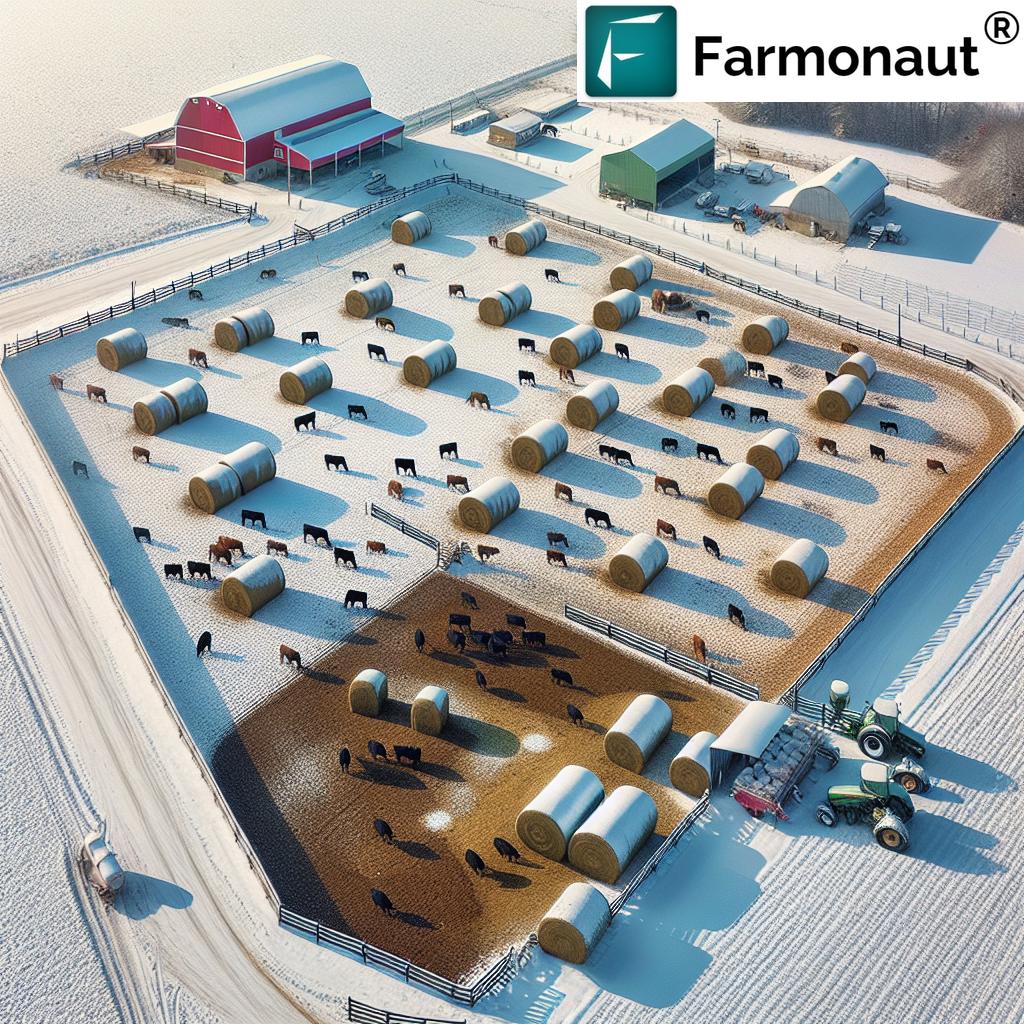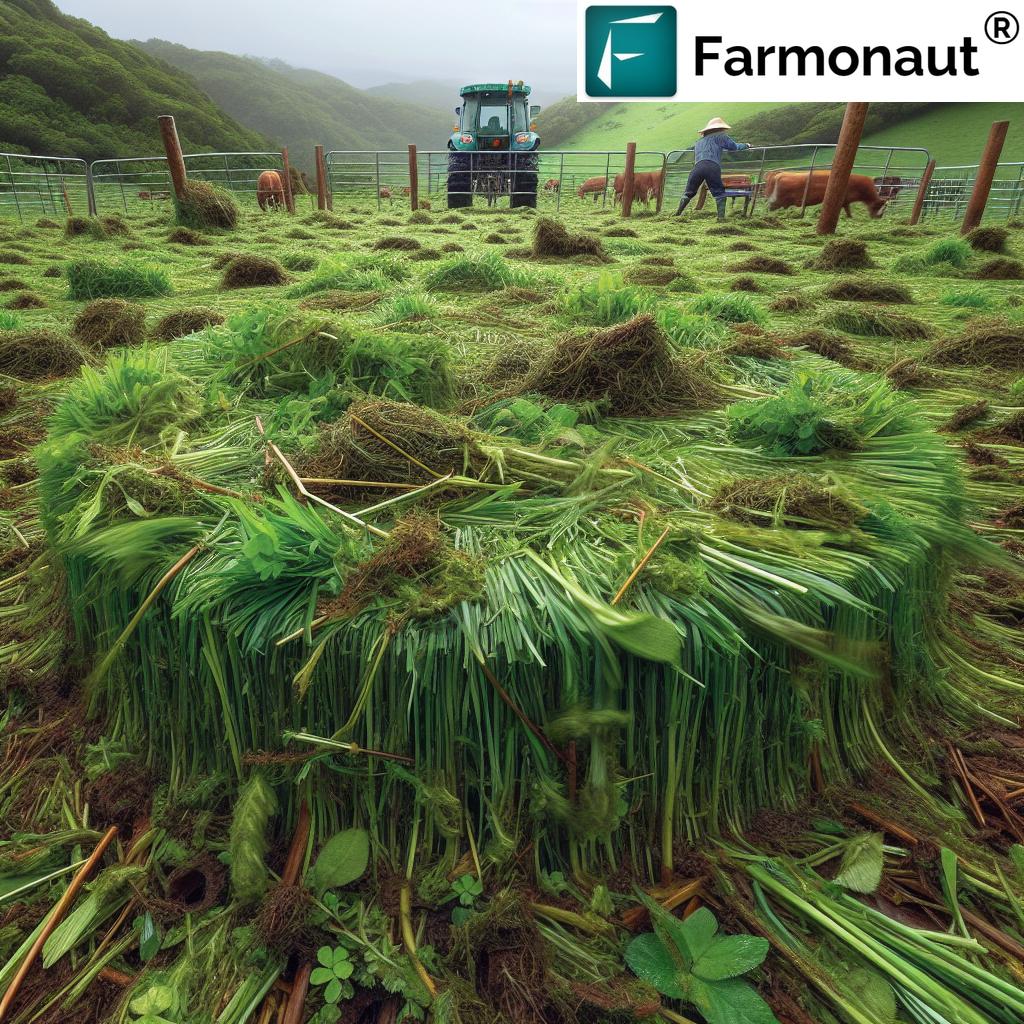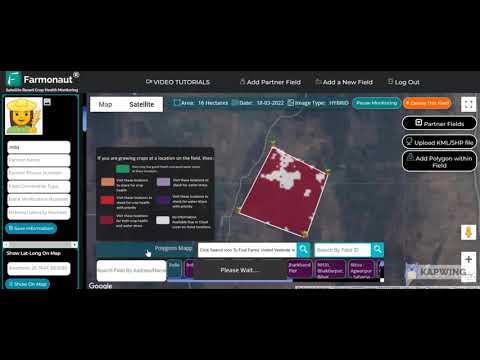Revolutionizing Winter Cattle Management: How Kentucky Farms Boost Soil Health and Efficiency with Bale Grazing
“Bale grazing can reduce winter feeding labor by up to 75%, saving farmers significant time and resources.”
In the heart of Kentucky’s rolling hills, a quiet revolution is taking place in the world of winter cattle management. Progressive farmers across the Bluegrass State are embracing innovative techniques that not only streamline their operations but also contribute to the long-term health of their land. At the forefront of this agricultural transformation is the practice of bale grazing, a method that’s reshaping how we think about winter feeding systems for cattle.
As we delve into the intricacies of this sustainable pasture management approach, we’ll explore how Kentucky farms are leading the charge in optimizing rotational grazing benefits while simultaneously enhancing soil fertility. This shift from conventional feeding methods to more efficient cattle feeding methods is not just a trend—it’s a testament to the ingenuity and forward-thinking nature of our agricultural community.

Understanding Bale Grazing: A Game-Changer for Winter Feeding
Bale grazing is a winter feeding technique that involves strategically placing hay bales across pastures before the onset of winter. This method allows cattle to graze directly from these bales throughout the cold months, eliminating the need for daily feeding and reducing the labor-intensive process of hauling hay to a central feeding area.
The concept is simple yet revolutionary. Instead of confining cattle to a single feeding area, which often becomes a muddy “sacrifice” area, bale grazing distributes the animals across the pasture. This distribution has multiple benefits:
- It prevents overgrazing and soil compaction in any one area
- It naturally spreads manure across the pasture, improving soil fertility
- It reduces the need for machinery to move feed daily, saving on fuel and labor costs
- It allows for better utilization of the entire pasture area during winter months
By adopting bale grazing techniques, Kentucky farmers are not only making their winter operations more efficient but also setting the stage for improved pasture health come spring.
The Kentucky Context: Adapting to the Fescue Belt Climate
Kentucky’s position within the Fescue Belt presents unique challenges and opportunities for winter cattle management. The predominance of tall fescue in our pastures means we have a grass species that can maintain its nutritional value well into the colder months. However, it also means dealing with potential fescue toxicosis issues and managing pastures to prevent overgrazing during critical growth periods.
Bale grazing aligns well with these regional considerations:
- It allows for strategic placement of bales to encourage grazing in areas that need improvement
- It can be used in conjunction with stockpiled fescue to extend the grazing season
- It provides an opportunity to overseed pastures with legumes or other forages as cattle graze, improving diversity and nutrition
As we at Farmonaut understand the importance of regional adaptation in agricultural practices, we’ve developed tools to help farmers make the most of their specific environmental conditions. Our satellite-based monitoring can assist in identifying areas ideal for bale placement and track pasture recovery post-grazing.
The Benefits of Bale Grazing: A Closer Look
Let’s break down the multifaceted advantages of implementing bale grazing on Kentucky farms:
1. Labor Reduction
One of the most immediate and tangible benefits of bale grazing is the significant reduction in labor. Traditional winter feeding methods often require daily use of tractors and equipment to move hay to feeding areas. With bale grazing, this daily chore is eliminated. Farmers report labor savings of up to 75%, freeing up time for other important farm tasks or simply improving work-life balance during the demanding winter months.
2. Soil Health Improvement
Perhaps the most exciting long-term benefit of bale grazing is its positive impact on soil health. As cattle graze around the bales, they deposit manure and urine directly onto the pasture. This natural fertilization process, combined with the trampling of uneaten hay, creates a perfect environment for soil microorganisms to thrive. Over time, this leads to:
- Increased organic matter in the soil
- Improved soil structure and water retention capacity
- Enhanced nutrient cycling and availability for future forage growth
“Implementing bale grazing techniques can increase soil organic matter by 2-3% within just a few years.”
3. Pasture Rejuvenation
Bale grazing acts as a passive form of pasture renovation. The areas where bales are placed receive intense animal impact, which can help break up compacted soil and create seed-to-soil contact for new forage establishment. This is particularly beneficial in the Fescue Belt, where overseeding with legumes or other forages can diversify pasture composition and improve overall forage quality.
4. Extended Grazing Season
By strategically placing bales across the pasture, farmers can extend their grazing season well into winter. This reduces the need for stored feed and allows cattle to maintain a more natural grazing behavior year-round. In Kentucky, where we often have periods of mild winter weather, bale grazing can be seamlessly integrated with grazing stockpiled fescue, further extending the season.
5. Environmental Benefits
Bale grazing contributes to environmental sustainability in several ways:
- Reduced fuel consumption and emissions from daily feeding operations
- Decreased soil erosion and runoff due to improved soil structure
- Enhanced carbon sequestration through increased organic matter in the soil
- Improved biodiversity in pastures due to varied grazing patterns and forage diversity
Implementing Bale Grazing: Best Practices for Kentucky Farms
While the concept of bale grazing is straightforward, successful implementation requires careful planning and management. Here are some best practices we’ve observed among successful graziers in Kentucky:
1. Strategic Bale Placement
The key to effective bale grazing lies in thoughtful bale placement. Consider the following factors:
- Topography: Place bales on higher ground to minimize mud and erosion
- Pasture condition: Use bale grazing to improve areas with poor soil or forage quality
- Water access: Ensure cattle have access to clean water sources throughout the grazing period
- Wind protection: Consider natural windbreaks when placing bales to provide shelter for cattle
2. Timing and Duration
In Kentucky’s climate, bale grazing typically begins in late fall or early winter. The duration can extend through early spring, depending on weather conditions and forage availability. It’s crucial to start bale grazing before the ground freezes to allow for proper stake placement and to minimize soil disturbance.
3. Stocking Rates and Paddock Management
Proper stocking rates are essential for successful bale grazing. Overstocking can lead to excessive trampling and waste, while understocking may result in uneven nutrient distribution. Many Kentucky farmers have found success with the following approach:
- Divide the pasture into paddocks using temporary electric fencing
- Allocate enough bales in each paddock to last 1-2 weeks
- Move cattle to a new paddock once the allocated bales are consumed
This rotational approach ensures even distribution of nutrients and prevents overgrazing in any one area.
4. Forage Quality Considerations
When implementing bale grazing, it’s crucial to consider forage quality. In the Fescue Belt, where tall fescue dominates, farmers should be mindful of:
- Testing hay quality to ensure it meets nutritional requirements of the herd
- Strategically placing higher quality hay for animals with higher nutritional needs (e.g., pregnant cows)
- Supplementing with minerals or protein as needed, based on forage analysis
5. Monitoring and Adaptation
Successful bale grazing requires ongoing monitoring and willingness to adapt. Farmers should regularly assess:
- Cattle condition and behavior
- Pasture impact and recovery
- Weather conditions and their effect on grazing patterns
This is where technology can play a crucial role. Farmonaut’s satellite-based monitoring tools can help farmers track pasture health and make data-driven decisions about grazing management.
Overcoming Challenges in Bale Grazing
While bale grazing offers numerous benefits, it’s not without its challenges. Kentucky farmers have had to innovate to overcome some common obstacles:
1. Mud Management
Kentucky’s winter climate can create muddy conditions, which can be exacerbated around bale sites. Successful graziers have addressed this by:
- Using portable platforms or sacrificial materials (like woodchips) around bales
- Implementing a rotation system to allow areas to recover
- Selecting bale sites on higher, well-drained ground
2. Waste Reduction
Some farmers initially worry about hay waste in bale grazing systems. However, many have found that strategic management can minimize waste:
- Using bale rings or other feeding structures for high-quality hay
- Accepting that some “waste” contributes to soil improvement
- Adjusting bale spacing to encourage more efficient grazing
3. Fencing and Infrastructure
Effective bale grazing often requires rethinking fencing strategies. Kentucky farmers have adapted by:
- Investing in portable electric fencing systems
- Creating permanent water access points throughout pastures
- Developing lane systems to facilitate cattle movement between paddocks
The Economic Impact of Bale Grazing
The adoption of bale grazing techniques has shown significant economic benefits for Kentucky cattle farmers. Let’s break down the financial implications:
1. Reduced Labor Costs
The most immediate economic benefit comes from reduced labor requirements. Farmers report:
- Up to 75% reduction in winter feeding labor hours
- Decreased fuel costs associated with daily feeding operations
- Reduced wear and tear on machinery, leading to lower maintenance costs
2. Improved Soil Fertility
The long-term economic benefits of improved soil health are substantial:
- Reduced need for commercial fertilizers due to natural nutrient cycling
- Increased pasture productivity, potentially allowing for higher stocking rates
- Enhanced drought resilience, reducing the need for supplemental feed in dry years
3. Extended Grazing Season
By extending the grazing season, farmers can realize significant savings:
- Reduced reliance on stored feed, lowering overall feed costs
- Decreased need for confinement feeding, reducing associated labor and facility costs
- Potential for improved cattle health and performance due to more natural grazing behavior
While the initial investment in fencing and water infrastructure may be necessary, many Kentucky farmers report that the long-term economic benefits far outweigh the upfront costs.

The Role of Technology in Optimizing Bale Grazing
As we embrace innovative grazing techniques, technology plays an increasingly important role in optimizing these practices. At Farmonaut, we’re committed to providing tools that enhance the efficiency and effectiveness of sustainable farming methods like bale grazing.
Satellite-Based Pasture Monitoring
Our satellite imagery technology offers farmers unprecedented insights into their pastures:
- Real-time vegetation health indices to track pasture recovery post-grazing
- Soil moisture monitoring to inform bale placement and prevent overgrazing in wet areas
- Historical data analysis to identify trends and optimize future grazing plans
AI-Driven Advisory Systems
Farmonaut’s AI technology can provide personalized recommendations for bale grazing strategies:
- Optimal bale placement based on topography and soil conditions
- Paddock rotation schedules that maximize grazing efficiency and pasture health
- Predictive analytics for forage growth and quality
Data-Driven Decision Making
By leveraging our comprehensive data analytics, farmers can make informed decisions about their bale grazing practices:
- Track the impact of bale grazing on soil fertility over time
- Analyze the cost-effectiveness of different grazing strategies
- Identify areas of the pasture that may benefit from targeted improvement efforts
These technological tools complement the hands-on experience of Kentucky farmers, allowing for a more precise and efficient implementation of bale grazing techniques.
Explore Farmonaut’s API for advanced agricultural data integration
Comparing Traditional and Bale Grazing Methods
To fully appreciate the impact of bale grazing on winter cattle management, let’s compare it to traditional feeding methods:
| Criteria | Traditional Feeding Methods | Bale Grazing Methods | Potential Benefits of Bale Grazing |
|---|---|---|---|
| Labor Requirements | Daily feeding, often requiring machinery | Initial setup, minimal daily management | Up to 75% reduction in labor hours |
| Soil Health Impact | Concentrated nutrient deposits, potential compaction | Distributed nutrient cycling, improved soil structure | 2-3% increase in soil organic matter within a few years |
| Forage Quality | Limited to stored feed quality | Opportunity for diverse forage integration | Improved pasture composition and nutrition |
| Environmental Impact | Higher fuel consumption, potential runoff issues | Reduced emissions, improved water retention | Lower carbon footprint, enhanced ecosystem services |
| Pasture Utilization | Often limited to sacrifice areas | Whole-pasture approach | More efficient use of land resources |
| Cattle Behavior | Confined feeding, potential stress | Natural grazing patterns maintained | Improved animal welfare and performance |
| Long-term Pasture Health | Potential for overgrazing and degradation | Promotes pasture rejuvenation and diversity | Sustainable improvement in carrying capacity |
| Farmonaut Technology Integration | Limited application | Satellite imagery for pasture monitoring, AI-driven advisory for optimal bale placement | Data-driven decision making, improved efficiency and sustainability |
This comparison clearly illustrates the numerous advantages that bale grazing offers over traditional winter feeding methods, particularly when enhanced by technology like Farmonaut’s satellite-based monitoring systems.
Case Studies: Kentucky Farms Embracing Bale Grazing
While we can’t provide specific case studies, we can share some generalized experiences from Kentucky farms that have adopted bale grazing:
1. Central Kentucky Beef Operation
A 500-acre farm in central Kentucky implemented bale grazing three years ago. They reported:
- A 60% reduction in winter feeding labor
- Noticeable improvement in spring pasture growth, particularly in areas where bales were placed
- Increased diversity in pasture composition, with volunteer legumes appearing in former bale sites
2. Western Kentucky Dairy Farm
A dairy operation in western Kentucky adapted bale grazing for their dry cows and heifers:
- Reduced machinery use led to significant fuel savings
- Improved body condition scores in animals on bale grazing compared to those in confinement
- Noticed a decrease in spring fertilizer requirements for pastures used for bale grazing
3. Eastern Kentucky Small-Scale Farmer
A small farm in the eastern part of the state used bale grazing as part of a pasture renovation strategy:
- Successfully established new forage species by overseeding areas used for bale grazing
- Reported improved soil water retention in bale grazed areas during summer dry spells
- Noted an increase in beneficial insect activity in pastures following bale grazing
These experiences highlight the versatility and effectiveness of bale grazing across different farm sizes and types in Kentucky.
The Future of Winter Cattle Management in Kentucky
As we look to the future of winter cattle management in Kentucky, it’s clear that practices like bale grazing will play an increasingly important role. The combination of traditional farming wisdom with innovative techniques and modern technology is paving the way for more sustainable, efficient, and profitable agricultural operations.
Key trends we anticipate seeing include:
- Increased adoption of bale grazing and other adaptive grazing techniques
- Greater integration of technology in pasture management decisions
- A shift towards more holistic farm management practices that prioritize soil health and ecosystem services
- Continued research and development of forage varieties suited for winter grazing in the Fescue Belt
At Farmonaut, we’re committed to supporting these advancements by continually improving our satellite-based monitoring and AI-driven advisory systems. Our goal is to provide Kentucky farmers with the tools they need to make informed decisions and optimize their winter cattle management strategies.
Explore our API Developer Docs for in-depth integration possibilities
Conclusion: Embracing Sustainable Innovation in Kentucky Agriculture
The adoption of bale grazing techniques represents a significant step forward in sustainable winter cattle management for Kentucky farms. By embracing this innovative approach, farmers are not only reducing their workload and expenses but also contributing to the long-term health and productivity of their land.
The benefits of bale grazing are clear:
- Substantial labor and cost savings
- Improved soil health and fertility
- Enhanced pasture utilization and diversity
- Reduced environmental impact
- Better alignment with natural grazing behaviors
As we continue to face challenges such as climate change and economic pressures, practices like bale grazing offer a way to build resilience into our farming systems. By working with nature rather than against it, we can create agricultural operations that are not only productive but also regenerative.
The future of winter cattle management in Kentucky is bright, and we at Farmonaut are excited to be part of this journey. Through our advanced satellite monitoring and data analysis tools, we’re committed to supporting farmers as they implement and optimize these innovative grazing strategies.
As we move forward, let’s continue to embrace the spirit of innovation that has always characterized Kentucky agriculture. By combining time-tested farming wisdom with cutting-edge technology and sustainable practices, we can ensure a thriving future for our farms, our communities, and our environment.
FAQ Section
Q: What is bale grazing?
A: Bale grazing is a winter feeding technique where hay bales are strategically placed across pastures before winter, allowing cattle to graze directly from these bales throughout the cold months.
Q: How does bale grazing improve soil health?
A: Bale grazing improves soil health by distributing manure and uneaten hay across the pasture, increasing organic matter, improving soil structure, and enhancing nutrient cycling.
Q: Is bale grazing suitable for all types of cattle operations?
A: While bale grazing can be adapted to many types of cattle operations, it’s particularly well-suited for beef cow-calf operations and dairy farms with dry cows or heifers.
Q: How can Farmonaut’s technology assist with bale grazing?
A: Farmonaut’s satellite-based monitoring can help farmers track pasture health, optimize bale placement, and make data-driven decisions about grazing management.
Q: What are the main challenges of implementing bale grazing in Kentucky?
A: The main challenges include managing mud in wet conditions, initial investment in fencing and water infrastructure, and adapting to a new management style.
Q: How does bale grazing affect winter feed costs?
A: Bale grazing can significantly reduce winter feed costs by decreasing labor, machinery use, and potentially reducing the total amount of hay needed due to more efficient utilization.
Q: Can bale grazing be used in conjunction with other grazing methods?
A: Yes, bale grazing can be effectively combined with other methods like stockpile grazing or strip grazing to create a comprehensive winter feeding strategy.






